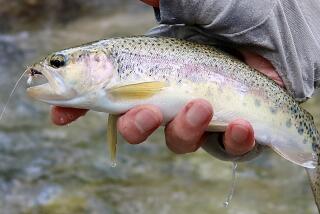Restoring the L.A. River
It’s certainly a stretch to describe the Los Angeles River we all know as “traditionally navigable.” But the Environmental Protection Agency’s welcome designation, which is essential to the river’s restoration, overturns previous decisions that made far less sense.
The EPA announcement Wednesday means the river will fall once again within the protection of the Clean Water Act, which, as written, applies vaguely to “waters of the United States.” In a 2006 ruling, the Supreme Court unfortunately narrowed that provision to cover only “navigable waters.” The court left room for administrative interpretation of what navigable meant, and the U.S. Army Corps of Engineers then chose the narrowest possible definition, saying that rivers must be not only navigable but “traditionally navigable.” Less than four of the river’s 51 miles fall within that definition.
In essence, the EPA has restored the meaning of the word “river” in the waterway’s title, rather than considering it, as the Corps of Engineers did, simply a flood control channel. Traditionally navigable rivers qualify for federal funding to remove pollutants and to be restored for recreational use. They are owed protection from development that would otherwise bury their tributaries — essential to maintaining flow — or add runoff that would foul their waters all the way to the ocean. Flood control channels, by contrast, are considered good for only one thing — to move water from the mountains to the ocean as quickly as possible.
The irony is that the L.A. River’s usefulness for boats and other water craft was diminished by the same concrete liners on its sides and much of its bottom that made it so good at preventing floods. The channels also kept the water from staying in the river longer and raising its depth and prevented groundwater from adding to the flow.
Protection under the Clean Water Act sets the stage for a multitude of ambitious plans, including removing the concrete liners and using modern technology to provide both flood protection and natural habitat that can attract wildlife and encourage human recreation. Plans to create badly needed parks and green spaces along the river — which also would attract new shopping and other commerce — would receive priority consideration. Proposed developments near the headwaters in the San Fernando Valley and along tributaries could neither pollute the river nor bury or harm its tributaries.
The new designation has far-reaching implications for similarly paved rivers throughout Southern California, which were unfairly left out of the nation’s water-protection scheme by the Supreme Court and Corps of Engineers. The EPA was right to look beyond the river’s current condition to its long-past history, and future promise, as a truly navigable river with all the benefits such waterways bring to the regions through which they course.
More to Read
Sign up for Essential California
The most important California stories and recommendations in your inbox every morning.
You may occasionally receive promotional content from the Los Angeles Times.










